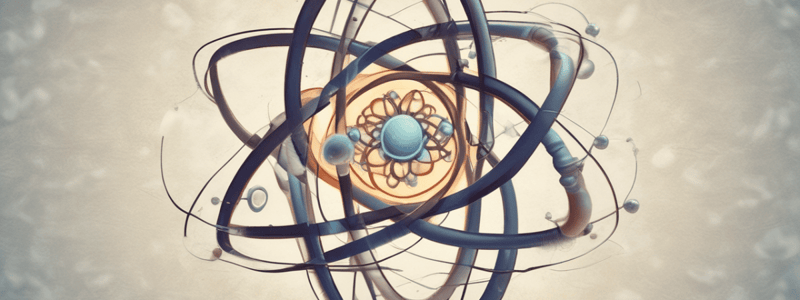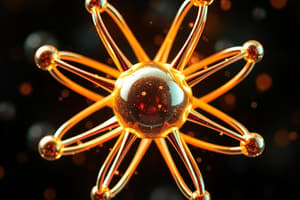Podcast
Questions and Answers
What was John Dalton's major contribution to the development of atomic theory in 1808?
What was John Dalton's major contribution to the development of atomic theory in 1808?
He proposed that atoms cannot be created or destroyed in the course of a chemical reaction, which is known as the Law of Conservation of Mass.
What was observed when cathode rays hit the glass tube in Crookes' experiment?
What was observed when cathode rays hit the glass tube in Crookes' experiment?
The glass tube glowed, and when an object was placed in the path of the cathode rays, a shadow was observed in the glowing area.
What conclusion did J.J. Thomson draw from the charge of cathode rays?
What conclusion did J.J. Thomson draw from the charge of cathode rays?
Thomson concluded that cathode rays were negatively charged because they were attracted to the positive plate.
What was the significance of J.J. Thomson's measurement of the charge-to-mass ratio (e/m ratio) of cathode rays?
What was the significance of J.J. Thomson's measurement of the charge-to-mass ratio (e/m ratio) of cathode rays?
What is the current understanding of the composition of atoms?
What is the current understanding of the composition of atoms?
Why do isotopes of the same element behave in a chemically similar manner to each other?
Why do isotopes of the same element behave in a chemically similar manner to each other?
What is the relative atomic mass (Aᵣ) of an element based on?
What is the relative atomic mass (Aᵣ) of an element based on?
What is the purpose of a mass spectrometer?
What is the purpose of a mass spectrometer?
How do ions get separated in a mass spectrometer?
How do ions get separated in a mass spectrometer?
What is the significance of the relative abundance of isotopes in calculating the relative atomic mass (Aᵣ) of an element?
What is the significance of the relative abundance of isotopes in calculating the relative atomic mass (Aᵣ) of an element?
What model did JJ Thomson propose to describe the structure of an atom?
What model did JJ Thomson propose to describe the structure of an atom?
Who suggested the name 'electron' for negatively charged particles?
Who suggested the name 'electron' for negatively charged particles?
What was the outcome of Rutherford's α-particle scattering experiment?
What was the outcome of Rutherford's α-particle scattering experiment?
Who discovered neutrons and what were they called?
Who discovered neutrons and what were they called?
What determines the position of an element in the periodic table?
What determines the position of an element in the periodic table?
Flashcards are hidden until you start studying
Study Notes
Atomic Theory
- All matter is made up of small particles called atoms.
- Atoms are indivisible and cannot be broken into simpler particles.
- John Dalton proposed an atomic theory based on the following:
- Atoms cannot be created or destroyed in a chemical reaction (Law of Conservation of Mass).
Atomic Structure
- Atoms consist of protons, neutrons, and electrons.
- The knowledge of atomic structure was built up through the work of many chemists, including:
- John Dalton (1808)
- William Crookes (1870)
- J.J. Thomson (1897)
- Robert Millikan (1911)
- Rutherford (1911)
Cathode Rays
- Cathode rays are invisible particles that travel from the cathode (negative terminal) to the anode (positive terminal) in a discharge tube.
- William Crookes conducted experiments to demonstrate the existence of cathode rays, including the Maltese Cross experiment.
- J.J. Thomson concluded that cathode rays are negatively charged and have a lighter mass than the lightest known atom.
Plum Pudding Model
- J.J. Thomson proposed the Plum Pudding Model, which describes an atom as a pudding with fruit dispersed through it.
- The pudding represents the positively charged protons, and the fruit represents the negatively charged electrons.
Electron
- The electron was discovered by J.J. Thomson and is a negatively charged subatomic particle.
- Johnstone Stoney suggested the name "electron" for these negatively charged particles.
- Robert Millikan measured the charge on an electron using the oil drop experiment.
Rutherford's Experiment
- Rutherford's experiment involved bombarding a thin gold foil with alpha particles.
- The results showed that:
- Most particles were not deflected at all.
- Many particles were deflected at small angles.
- A small number of particles were deflected at angles greater than 90°.
- A small number of particles bounced back towards their source.
- Rutherford concluded that:
- The positive charge is concentrated into a dense nucleus in the centre of the atom.
- The rest of the atom is empty space, allowing particles to travel through undisturbed.
Protons and Neutrons
- Rutherford discovered that positively charged particles identical to a hydrogen atom were emitted when an atom was bombarded.
- He concluded that these positively charged particles were produced from the break-up of the nucleus and called them protons.
- James Chadwick produced evidence for the existence of neutral particles and called them neutrons.
Nucleus and Electron Energy Levels
- The nucleus is the central part of the atom that contains protons and neutrons.
- Electron energy levels are the different orbits that electrons can move in around the nucleus.
Properties of Electrons, Protons, and Neutrons
- Electron:
- Relative mass: 1/1836
- Relative charge: -1
- Location: Outside the nucleus
- Proton:
- Relative mass: 1
- Relative charge: +1
- Location: Nucleus
- Neutron:
- Relative mass: 1
- Relative charge: 0
- Location: Nucleus
Atomic Number and Mass Number
- Atomic number: The number of protons in the nucleus of an atom, which determines the element's position in the periodic table.
- Mass number: The sum of the number of protons and neutrons in the nucleus.
Isotopes
- Isotopes are atoms with the same number of protons but different numbers of neutrons.
- Isotopes have the same atomic number and therefore occupy the same position in the periodic table.
- Isotopes behave in a chemically similar manner but may have differences in their physical properties.
Relative Atomic Mass (Aᵣ)
- Aᵣ is a measure of the average mass of an element based on the relative abundance of each isotope of that element.
- Aᵣ is the average mass of an atom of the element relative to 1/12 the mass of an atom of Carbon-12.
Mass Spectrometer
- A mass spectrometer is used to measure the masses of atoms and identify unknown compounds.
- The mass spectrometer analyses a sample and identifies:
- The mass of each isotope present.
- The percentage of each isotope present.
- These values are used to calculate the Aᵣ of the substance.
How a Mass Spectrometer Works
- The mass spectrometer works on the principle that ions can be separated according to their mass.
- The process involves:
- Vaporisation of the sample.
- Ionisation of the gas.
- Acceleration of the ions.
- Separation of the ions based on their mass.
- Detection of the ions and measurement of their abundance.
Studying That Suits You
Use AI to generate personalized quizzes and flashcards to suit your learning preferences.




